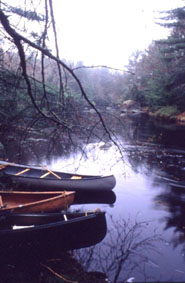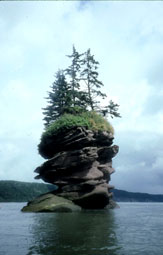
![]()
Volume 7, No. 1
Promoting Cooperation to Maintain and Enhance
Environmental Quality in the Gulf of Maine
|
||||||||||
|
|
|
|
|
|
|||||||
|
|
|
|
Browse the archive |
|
|
|
|
Gulf Log
Fishermen losing waterfront access
More than 10,000 commercial fishermen in Maine rely on shore access to sustain the health of their $846 million industry, yet demographic changes along the coast threaten to sever this vital economic link, according to a recent report released by the Maine Coastal Program, “Preserving Commercial Fishing Access.”
“Among the 25 coastal communities surveyed, we learned that it is increasingly difficult for fishermen to get their product to market,” says Elizabeth Sheehan of Coastal Enterprises, Inc. and the co-author of the study.
Rising property taxes, development pressure and competition from recreational users are making it more difficult for fishermen to gain access to the waterfront. The study shows that only 25 percent of access is provided by publicly owned facilities. The remaining 75 percent is provided through private pier operations and residences, which are vulnerable in the current real estate market.
 |
| The Tobeatic Wilderness Area Photo courtesy of the Tobeatic Wilderness Committee |
Steve Train, a lobsterman from Long Island who served on the advisory committee for the study, explains that for small coastal communities, “If you lose access, you lose jobs and eventually you lose schools, volunteer fire departments and stores. The whole infrastructure of the community depends on its major industry, which often is still commercial fishing.” The report found that 80 percent of the towns surveyed are planning to preserve or improve future access. Nearly all of them have already sought funding assistance through the state’s Small Harbor Improvement Program, which awards grants to help upgrade public infrastructure.
The report can be found online at http://www.state.me.us/mcp/online_resources/ftp.html.
Habitat value worth more intact
A study in the journal Science confirms, using the language of economics, what many ecologists have long suspected - that protecting wilderness is a bargain. The scientific study, entitled “Economic Reasons for Conserving Wild Nature,” found that protection and restoration of wild nature had a benefit-cost ratio of around 100 to 1 in favor of conservation. They defined wild nature as habitat in which biodiversity and ecosystem functioning are sufficiently intact.
The authors synthesized hundreds of case studies involving freshwater marshes, forests and marine habitats. Factoring in the benefits of a habitat’s “ecosystem services,” like clean air, clean water and flood prevention, or social benefits like hunting or tourism, they found that intact habitat was worth far more on average than converting it to timber, farmland or fish farms.
The reasons the public ignores the net benefit of conservation, the researchers say, include lack of information, the failure of markets to “capture” and value the services provided, and tax incentives and subsidies that encourage conversion. Ways of putting a market price on ecosystem services include carbon credits (where companies working to reduce the carbon dioxide content in air are given “credits”), higher prices for eco-friendly products and direct payments to local communities in significant conservation areas.
One author, David Constanza of the University of Vermont, noted “Natural capital is going to be more valuable as it becomes more scarce. In many cases we have passed the point where development is worth more to us than conservation. Global ecological sustainability through widespread habitat protection and restoration is the moral, ecological and indeed, economic imperative of our time.”
Ballast water violators face fines
As part of an evolving federal ballast water management plan, the U.S. Coast Guard has proposed imposing fines of up to $25,000 a day on vessels that fail to exchange their ballast water at sea before entering a U.S. port, or fail to submit reports documenting the exchange.
Ships carry thousands of gallons of ballast water to help stabilize them during voyages. But often lurking within ballast holds are marine creatures that if discharged in a receiving port can imperil coastal ecosystems. Lacking adequate and cost-effective technologies to treat ballast water, experts say discharging ballast water at sea is one of the best ways to prevent the spread of exotic marine species.
Ballast water exchange involves replacing coastal water with open ocean water during a voyage. The process reduces the density of coastal organisms in ballast tanks that may be able to invade a recipient port, replacing them with open ocean organisms with a lower probability of surviving in coastal waters. According to the National Ballast Water Survey, ships navigating New England waters exchange far less ballast water than other parts of the country. But among the New England states, Maine has the highest discharge rates due largely to the higher number of bulk carriers that visit the state’s ports.
The agency has also proposed broadening reporting and record keeping rules to include all vessels bound for ports or places within the United States, with minor exceptions. Currently, only those vessels entering U.S. waters after operating outside of the 200-mile Exclusive Economic Zone (EEZ) must submit ballast water management reports and keep accurate ballast water management records. Under the proposed changes, all vessels operating in United States waters bound for ports or places in the United States would have to submit these reports and keep records, regardless of whether they operated outside of the EEZ.
Among the nonnative species that have invaded the Gulf of Maine watershed by catching a ride in ballast water are the rapa whelk and Asian shore crab. Researchers are also concerned that disease-carrying microbes may be carried in ballast.
Two Bay of Fundy rivers listed most endangered
The Petitcodiac River causeway has rendered a once meter-high tidal bore that raced up the river at 13-kilometers an hour [eight miles] down to a ripple. For years conservationists have fought to remove or at least open the causeway gates so that anadromous fish could pass freely. Local landowners living around the lake formed by the causeway have objected, setting into motion years of studies and heated town meetings. Now Earthwild, a Canadian conservation group, has listed the Petitcodiac as the second most endangered river in Canada.
Across the Bay of Fundy in Nova Scotia, the Cornwallis River, a 45-kilometre [28 mile] stream that meanders through the Annapolis Valley came in 10th and last on the list. The reasons: agricultural pollution and irrigation. Around 42 percent of the Cornwallis watershed is devoted to agriculture uses.
 |
| New Brunwick sea stack or “flowerpot” Photo courtesy of Sue Hutchins and Dan Earle |
As for New Brunswick’s Petitcodiac, the provincial and federal governments are undertaking a $3 million environmental impact assessment on options to restore the river. Those options include constructing a new fishway, opening the causeway gates during peak migratory periods, opening the gates permanently and constructing a partial bridge. The report is due out next year.
For information on the Petitcodiac Environmental Impact Assessment go to: http://www.petitcodiac.com/index-e.html. Friends of Cornwallis River can be reached at (902) 678-8351.